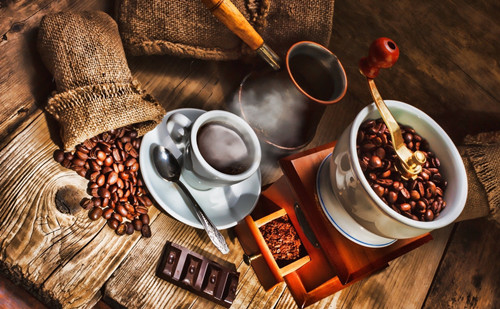Exotic Turkish Coffee to know the Source of Turkish Coffee

Tired of fashionable coffee, learn about the origin and culture of Turkish coffee and how to make Turkish coffee. I began to like this old handmade coffee.
Tired of coffee fashion? Maybe I prefer things from five hundred years ago. At first, I didn't say I liked Turkish coffee, but I was attracted by the beautiful Turkish coffee pot. I have always liked this kind of handicrafts with national characteristics, such as Turkish coffee pots, exotic handicrafts made by local traditional craftsmen, have an unusual attraction to me.
Turkish coffee pot:
The Turkish coffee pot is actually just a general term. This small coffee pot with a long handle has a special name called cezve or ibrik, not only in Turkey, but also in the Middle East, Eastern Europe, North Africa and Greece. The body of the pot is made of pure copper and is tinned with intricate hand-carved patterns, and the wooden handle is inlaid with copper wire and natural shells. The whole pot exudes exquisite and simple temperament, in fact, the workmanship is not perfect, and some details are even a little rough, but it is this combination of fine and clumsy that is more handmade, less accurate and standardized industrial coldness, and more human touch.
Turkish coffee culture:
Coffee culture has developed vigorously in China in recent years, and people have been exposed to a variety of coffee-making methods, but Turkish coffee has never become the mainstream, and even this ancient cooking method is no longer popular in Turkey, the country of origin. A friend came back from Turkey and said that local cafes were also occupied by Espresso, lattes and cappuccinos. It seems that espresso has swept the world. Only some old cafes and performance cafes in tourist destinations still offer this traditional coffee. However, not many locals drink coffee, and people prefer black tea. It is precisely because of the unpopularity of Turkish coffee that we all know that there are many people who drink Turkish coffee, but very few have actually drunk it, thus causing a lot of misunderstandings and even prejudices.
Many people imagine that Turkish coffee is a heavy-flavored drink full of bitterness and coffee grounds. Most of the introductions to Turkish coffee on the domestic network say that spices should be added, and some even say that ginger should be added. This is actually a wrong understanding. Turkish coffee will never add spices, and the only seasoning that will be added is sugar. The flavored coffee is Arabica coffee. Because of the same way of cooking, the people who first introduced Turkish coffee confused the two kinds of coffee, and because this way of making coffee was not popular, we didn't bother to verify it. When writing introductions, they quoted each other at will, resulting in this mistake in most articles introducing Turkish coffee on the Internet. This deepens people's misunderstanding of Turkish coffee, which is too taunting and is often used to make fun of adding all kinds of strange seasonings to the coffee. In fact, Turkish coffee is more acceptable than other production methods. For example, when you used to drink coffee with milk and sugar, you could accept Turkish coffee. Even now you are used to tasting single-item coffee, you still find Turkish coffee more pleasing.
The making of Turkish coffee:
The making of Turkish coffee is actually very simple. It is suitable to choose moderate or deep-roasted coffee beans, unlimited varieties of beans. Ground into a fine powder, the powder must be fine and fresh enough to make a rich foam, which is very important for a cup of Turkish coffee, as we will talk about later. Put the ground coffee powder into the pot and add cold water. Coffee brewed in cold water tastes more mellow than hot water. Generally speaking, the amount of Turkish coffee is about 50ml, and the ratio of powder to water is the water added to 65ml for every 5-6g powder.
If you want to add sugar, be sure to add it before cooking. This is not difficult to understand, because the cup of Turkish coffee will have coffee grounds more or less, if you pour sugar into the cup, the coffee grounds will be mixed together when stirred. There are four flavors of Turkish coffee: sade, az sweet ekerli, orta sweet ekerli and ç ok sweet ekerli. What I do is, bitter without sugar, slightly sweet with half a pack of sugar per cup, Zhongtian with 3 packets of sugar per cup, and sweet with 1 packet of sugar per cup.
After the coffee powder, water and sugar are added to the pot, stir slightly with a spoon so that they are basically well mixed, and then you can boil them on the stove. Use low heat when cooking, do not keep stirring with a spoon, it will destroy the coffee liquid and produce foam. As mentioned earlier, foam is very important to Turkish coffee. A qualified Turkish coffee should be covered with a fine layer of foam. When the coffee liquid is about to boil, there will be a very thick layer of foam on the surface. At this time, the pot should be removed from the fire and the foam should be poured into several coffee cups averagely. For locals, the more distinguished guests there are, the more foam there is in the cup. In particular, I would like to point out that many articles on Turkish coffee say that Turkish coffee should be boiled three times. In a sense, this is not wrong, but not to boil for the sake of boiling, but to boil many times to produce foam to pour into the cup. After pouring the first foam, put the pot on the stove to continue to heat, boil and then leave the fire, pour the foam into the cup, usually boil to the third time there is no foam, you can turn off the heat and pour the remaining coffee liquid into several cups. So generally speaking, it is right to boil three times, but it is not to boil after the foam has dissipated, but to pour out the foam every time it boils. Perhaps the first person who put forward this statement did not understand why it should be boiled three times, and everyone did not look into it, so they made a mistake. If you have the opportunity to go to Turkey, go to the old local cafe to buy a bag of freshly ground coffee powder that specializes in brewing Turkish coffee. This cooking method is written in detail on the package.
Turkish coffee doesn't taste like crap as people think. No matter what shape the Turkish pot is narrow at the top and wide at the bottom, it is designed to leave the coffee grounds at the bottom of the pot when the coffee liquid is poured out. In fact, you can't pour out the slag when you pour it, and almost all the dregs in the cup are poured into the foam. After pouring into the cup, the coffee grounds will also precipitate into the cup, without stirring, there is no residue to drink. Of course, a cup of Turkish coffee usually drinks only 3GP4. If you want to drink it upside down, you will definitely get dregs. The rest of the coffee grounds in the cup can be used for divination by locals.
The taste of Turkish coffee:
Turkish coffee has a rich aroma and mellow taste, with no bitterness and no sour taste at all. It is very sticky, with a syrup-like taste and a caramel taste, strong but not irritating. Yu Yun stays in the mouth for a long time. Even people who don't drink coffee a lot will find it delicious.
In fact, the way of brewing Turkish coffee like this is very simple, it doesn't take any skill to make a good cup of coffee. You don't have to have a special appliance. You can try it with a small milk pot or a small pot. After drinking it, you may also fall in love with this unique taste.
Important Notice :
前街咖啡 FrontStreet Coffee has moved to new addredd:
FrontStreet Coffee Address: 315,Donghua East Road,GuangZhou
Tel:020 38364473
- Prev

Irresistible coffee charm, the best assistant in work and life.
I believe that for most people, the word coffee is not unfamiliar, and some people even regard coffee as the best assistant in their work life. Indeed, the meaning of coffee itself has the meaning of power and enthusiasm. When tired, soak a cup of rich fragrant coffee, all the troubles and unhappiness are left behind. Coffee, tea and cocoa are the three most popular and inseparable days
- Next

Coffee common sense coffee is the most popular cappuccino coffee
Cappuccino coffee also originated in Italy and was invented by a scientist. Foamed milk plays a very important role in this coffee. This is also the most important feature of cappuccino, a layer of foaming milk, bring milk foam to the coffee sweet and delicious. Like other coffee, cappuccino coffee originated in Italy and was invented by a scientist. This type of coffee
Related
- Beginners will see the "Coffee pull flower" guide!
- What is the difference between ice blog purified milk and ordinary milk coffee?
- Why is the Philippines the largest producer of crops in Liberia?
- For coffee extraction, should the fine powder be retained?
- How does extracted espresso fill pressed powder? How much strength does it take to press the powder?
- How to make jasmine cold extract coffee? Is the jasmine + latte good?
- Will this little toy really make the coffee taste better? How does Lily Drip affect coffee extraction?
- Will the action of slapping the filter cup also affect coffee extraction?
- What's the difference between powder-to-water ratio and powder-to-liquid ratio?
- What is the Ethiopian local species? What does it have to do with Heirloom native species?

